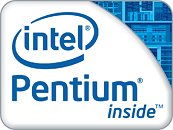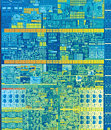Wednesday, January 11th 2017

Intel Adds Hyper-Threading to Its Kaby Lake-based Pentium CPUs
Intel Corporation has made a slight tweak to its product line: the addition of Hyper-Threading to some of its processors which, traditionally, didn't carry it. This includes the Pentium G4620 (3.7 GHz base frequency and integrated graphics HD 630, $93) and G4600 (3.6 GHz base frequency, $82), both at 51 W TDP; G4560 (54W TDP at 3.5 GHz and integrated HD 610 graphics, $64); and the Pentium G4600T (3 GHz, HD 630, $75) and G4560T (2.9 GHz, HD 610, $64) slot in as the low power Pentium offerings with a 35W TDP. All of these processors now carry 2 physical cores, which the system sees exposed as 4 logical cores due to their Hyper-Threading enablement.In a bid to differentiate these microprocessors from their i3 line (which seem dangerously close in specs now), the Pentiums forgo the Advanced Vector Instructions 2 (AVX2) extension set, of which generally database processing and video editing tend to take advantage, though these are probably use cases for which the particular market for this processors won't be planning on running them as a priority.
Pricing is the key difference between the two, as the Kaby Lake-based i3 chips command a ~$53-$63 premium over these Pentium counterparts, with an expected performance delta being much, much less than that value (the base frequency difference between the i3 7100 and the Pentium G4620 stands at a mere 200 MHz in favor of the former).
All in all, an interesting, if long coming, change to Intel's line. That we still have to contend with dual-core, four-threaded CPUs in 2016 is a sign of the stagnant CPU market we've been living for a few years now; but it's definitely much, much better than last year's proposition, where you'd have to contend with a mere two cores in a low-end system. Whether or not this is a sign of Intel preparing for the Ryzen onslaught, only the Intel higher-ups know, though it does seem strange for that being the reason, considering that Ryzen is supposed to tackle, at its minimum, a completely different segment of the market.
Pricing is the key difference between the two, as the Kaby Lake-based i3 chips command a ~$53-$63 premium over these Pentium counterparts, with an expected performance delta being much, much less than that value (the base frequency difference between the i3 7100 and the Pentium G4620 stands at a mere 200 MHz in favor of the former).
All in all, an interesting, if long coming, change to Intel's line. That we still have to contend with dual-core, four-threaded CPUs in 2016 is a sign of the stagnant CPU market we've been living for a few years now; but it's definitely much, much better than last year's proposition, where you'd have to contend with a mere two cores in a low-end system. Whether or not this is a sign of Intel preparing for the Ryzen onslaught, only the Intel higher-ups know, though it does seem strange for that being the reason, considering that Ryzen is supposed to tackle, at its minimum, a completely different segment of the market.


41 Comments on Intel Adds Hyper-Threading to Its Kaby Lake-based Pentium CPUs
Seems like a preemptive response to Ryzen.
On topic, I would like to think this is a sign of the transition to come soon as other comments have pointed out, and see a bump up in core/thread count across the entire product stack.
It should be:
Celerons = 2c/2t
Pentiums = 2c/4t
Core i3 = 4c/4t
Core i5 = 4c/8t
Core i7 = 6c+/12t+
The original line-up was conceived with this mindset:
Celeron = bare minimum, not meant for gaming
Pentium = Can run games ok. But only for budget builds
i3 = Good gaming CPU, not meant for super cards.
i5 = Good enough for the overwhelming majority of builds (Including enthusiast).
i7 = Massive overkill for gaming. Only for the most extreme builds or future proof-ing.
That was fine until around 2013 when all games started using 8 threads, and many games wouldn't even START without 4 threads. At that point a 2c/4t is really the "Minimum" anyone should choose for gaming, and 4c/8t is the norm for good gaming builds. Hence why I dropped all support for the i5 a couple years ago. i3's are 80% the performance for half the cost, and if you actually want a good gaming CPU - an i7 is mandatory.
People need to stop saying just the core count too. Number of THREADS is what matters.
So he is correct in what he is saying :)
Edit: Its called The Great Suspender. Install that add on to Chrome and that helps with lower CPU usage when opening up multiple tabs :)
To me it seems like for most applications both i3 and i5 have become irrelevant for new builds. Either you need the extra performance (threads) of a Core i7 or a Pentium will be good enough at a fraction of the cost.
If you time and look at 2 different cpus like a 3.5GHz vs a 4.8GHz the loading is substantially faster on the 4.8GHz
News sites are the worse for obvious reasons.
Slickdeals loads substantially faster on my desktop vs ultrabook.
For gaming at 1080p with a decent graphics card I'd place games into three categories:
1. Games that run well on a Pentium G4560. This is currently the majority of games, and many of the to-be-released as well.
2. More CPU demanding games that run sluggish with Pentium but fluent on higher end Core i5. There are a couple of these, mostly strategy type. Tekken 7 seems to fit here.
3. Games that refuse to start unless you have a higher end Core i5 and will run better on Core i7. There are a select few of these at the moment, for example Forza Horizon 3, but a couple more seems to be on their way. Sniper Ghost Warrior 3 seems to fit here.